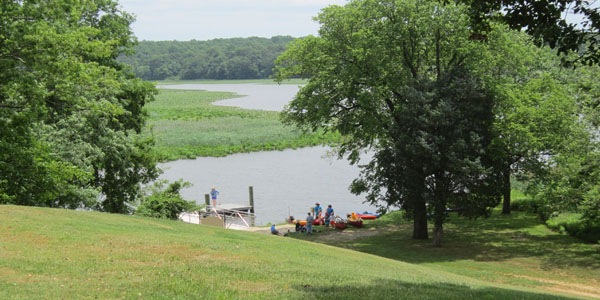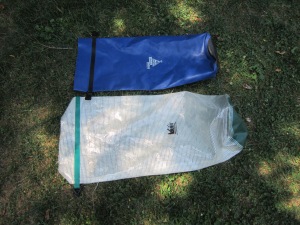It looks like the CCA redesigned their web site so I have updated the links to the new links. Instead of a pdf document which lists the trip calendar, it is now an online calendar. Look for the events that are aqua, as they are the novice (easy) trips. There is a link to the legend in the right hand corner of the page. (Updated April 10, 2016)
If you have never been canoeing with a canoe club before, this article is going to give you some hints on how to proceed. There are a couple of beginner, novice and practiced novice trips posted so far on the CCA Trip Calendar. (Canoe Cruisers Association of Washington, DC)
How to Read the CCA Trip Schedule
The main page of the Canoe Cruisers Association of Greater Washington gives an overview of the club and includes a link to the Trip Schedule. I’m going to make the assumption that the reader is a novice paddler or if not a novice paddler, wants to paddle places with children and therefore is paddling with novice paddlers. If that is not your case, then ignore these basic instructions.
When you look at the Trip Schedule, the most important things to look at are the dates and the level. It also tells you where the trip goes and who is coordinating the trip and how to reach that person. If it says “dealers choice”, that means when it comes time to figure out the river to go on the coordinator is going to choose from what rivers are deep enough to paddle at that time. (With the new trip calendar, trips that say “BRV” and “MCC” are referring to trips that other clubs are leading – Blue Ridge Voyagers and Monocacy Canoe Club.)
The Trip Guidelines state:
Novice – Beginning paddler who is proficient in flat water, knows basic strokes and can maneuver the boat in Class 1-2 moving water.
Practiced Novice – Same skills as novice but more experienced in adjusting to unexpected changes in water level and weather conditions.
CCA is mostly a whitewater club. For my family trips, I do not assume you know how to paddle in class 1 or class 2 moving water. I do assume you know how to get in and out of your boat safely and how to keep yourself and your family safe. Also how to paddle well enough to go in a relatively straight line. The water will be moving, whether because of tides or because of wind or both, so it is not quite the same as paddling on a pond with no wind.
CCA is reaching out to gain the next generation of paddlers and by offering some flat water trips to attract families and other beginners, we hope to keep our paddling club going for future generations.
Determining Which Trip to Go On
So you should first determine what your skill level is and if you can participate in the trip posted. For my beginner trip, there is no experience necessary, but that doesn’t mean you can just show up without contacting the coordinator first. For PN (practiced novice), the trip leader will want to know what your skill is.
Once You Have Selected a Trip of Interest
One or two weeks ahead of the trip, you email or call the trip coordinator and let them know your interest in the trip. The coordinator is going to ask questions to determine if you know what you are doing. For a PN (practiced novice) trip, the coordinator is going to want to know what type of boat you are paddling, how long you have been paddling, and what rivers you have done before. If you are in a kayak, the coordinator will ask about your rolling skills.
For a beginner trip, (which I am leading this year), I’m going to ask what type of boat you have. If you don’t have a boat, are you renting a boat? I will ask about who is coming in your party, names and (if children) ages. I will ask if you have a life vest for each member of your party and if you know how to determine what size life vest is appropriate for children – if you are bringing children. Life vests must be warn when boating in Maryland and on all CCA trips. If you are coming in a kayak, I’m going to find out what type. If it is a whitewater boat, I will want to make sure you have a helmet and spray skirt. If it is a flat water kayak, then you don’t need either, as the cockpit is much larger.
If you are canoeing or kayaking, I’m going to assume you know how to swim! If you don’t know how to swim and you are over the age of 10, then you should probably not be canoeing. So if you can’t swim, please do not go on a club trip. This is a basic assumption.
Your Preparation Before a Trip
On a club trip, everyone is 100% responsible for themselves. So before the trip, consider what type of clothes to wear for the day. I wrote about what to bring paddling in a previous post. If it is cool, then you want to wear some clothes to keep you warm, like nylon pants and a polypropylene top. You will want a hat for sun, water for each person (at least a quart per person), some food for lunch. You will need a dry bag to keep your gear dry. In the case of a beginner trip, I guess you don’t need a dry bag, but you will need something to contain your gear in your boat, maybe a duffle bag.
If you are renting a boat, you need to make reservations before the trip. So when you contact the trip leader, contact the canoe livery and get a canoe or kayak reservation at the same time. If you are renting and have children, consider bringing their own life vests. I have found many places that rent canoes are not adequately stocked with life vests sized for children.
In Case You Have to Cancel
If you have to cancel please call or email the trip coordinator to let them know you have a change of plans so we will not be waiting for you.
The Day of the Trip
If the meeting time is 10:00 am, that doesn’t mean you pull into the parking lot at 10:00 am, that means you have already arrived and taken your boat off your car and gotten all your stuff together by 10:00 am. Most trips require a shuttle, so in those cases you may want to keep your boat on your car and inquire about who will be carrying boats versus keeping their car at the takeout.
The flat water trips I am leading do NOT require a shuttle, as they are out and back rivers flat water trips for families and beginners of all kinds.
If you are renting a boat, you don’t show up at the rental office at 10:00 am when the leader said the trip was meeting at 10:00 am. You need to get your boat before the meeting time.
On places that have boat ramps, you drive your car to the boat ramp, unload your boat(s) and all your equipment and then drive to the parking spaces provided. Boat ramps are not meant for parking.
Don’t Leave Valuables in the Car
DO NOT leave valuables in the car. That means you need to take them with you. So you are going to need something dry to keep your keys (if you have a remote lock) and your wallet and maybe your cell phone if you brought it. I have had stuff stolen out of my car before I wised up and realized to never leave valuables in the car.
Trips for Families
If you are going on one of my family trips and you have children, consider bringing some pool noodles and a floating ball to play with. In warm weather, squirt guns are fun. In cool weather, leave the squirt guns at home. I wrote about Canoeing with Children in this post.
At the Meeting Site
Introduce yourself to the coordinator. If you have any questions, ask. Be helpful to other people. Once you have gotten your boats off the car, see if others may need help. This is especially important with beginner paddlers, who may not be used to slinging boats on and off of cars.
On the River or In the Parking Lot
Introduce yourself to other paddlers in the group. Paddling with a club is a great way to socialize and meet new people. After I got to a certain level of paddling, I decided what was more important to me was the people I went with and not the river I went on. I have made a couple of lifetime friends that I met paddling or met somewhere else and invited paddling with me. What really drew me into paddling was the friendly people. I had actually started out rock climbing, but decided I liked the paddlers better, so I pursued paddling and not rock climbing.
After the Trip
Don’t forget all your stuff. Pull your car up to the boat ramp, but don’t keep your car there longer than necessary. Help people who are struggling with their equipment. If you have food to offer, offer it around. And lastly, thank the trip coordinator. And consider joining the CCA. I will be handing out membership forms at the end of my trips.
Follow FamilyCanoeingDC on Facebook to get notified about upcoming novice and practiced novice trips.



Pingback: Canoeing Trips with a Club – Kayaks of course welcome | James's Blog